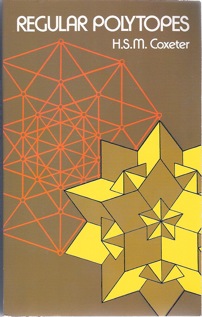Regular Polytopes (book)
 Cover of the Dover edition, 1973 | |
| Author | Harold Scott MacDonald Coxeter |
|---|---|
| Language | English |
| Subject | Geometry |
| Published | 1947 |
| Publisher | Methuen, Dover Publications |
| Pages | 321 |
| ISBN | 0-486-61480-8 |
| OCLC | 798003 |
| Preceded by | Dimensional Analogy (1923 essay) |
Regular Polytopes is a mathematical geometry book written by Canadian mathematician Harold Scott MacDonald Coxeter. Originally published in 1947, the book was updated and republished in 1963 and 1973.
The book is a comprehensive survey of the geometry of regular polytopes, the generalisation of regular polygons and regular polyhedra to higher dimensions. Originating with an essay entitled Dimensional Analogy written in 1923, the first edition of the book took Coxeter twenty-four years to complete.
Overview

Regular Polytopes is a standard reference work on regular polygons, polyhedra and their higher dimensional analogues. It is unusual in the breadth of its coverage; its combination of mathematical rigour with geometric insight; and the clarity of its diagrams and illustrations.
Coxeter starts by introducing two-dimensional polygons and three-dimensional polyhedra. He then gives a rigorous combinatorial definition of "regularity" and uses it to show that there are no other convex regular polyhedra apart from the five Platonic solids. The concept of "regularity" is extended to non-convex shapes such as star polygons and star polyhedra; to tessellations and honeycombs and to polytopes in higher dimensions. Coxeter introduces and uses the groups generated by reflections that became known as Coxeter groups.
The book combines algebraic rigour with clear explanations, many of which are illustrated with diagrams, and with a diagramatic notation for Wythoff constructions. The black and white plates in the book show solid models of three-dimensional polyhedra, and wire-frame models of projections of some higher-dimensional polytopes. At the end of each chapter Coxeter includes an "Historical remarks" section which provides an historical perspective of the development of the subject.
The challenge of comprehending higher dimensions was addressed by Coxeter on page 118: "There are three ways of approaching the Euclidean geometry of four or more dimensions: the axiomatic, the algebraic (or analytical) and the intuitive. The first two have been admirably expounded by Sommerville and Neville, and we shall presuppose some familiarity with such treatises."[1] Concerning the third, Poincaré wrote: "A man who really pursues it, will end up holding on to the fourth dimension".
Contents
The contents of the third edition (1973) of Regular Polytopes are as follows:
- Section I. Polygons and Polyhedra
- Section II. Regular and Quasi-Regular Solids
- Section III. Rotation Groups
- Section IV. Tessellations and Honeycombs
- Section V. The Kaleidoscope
- Section VI. Star Polyhedra
- Section VII. Ordinary Polytopes in Higher Space
- Section VIII. Truncation
- Section IX. Poincaré's Proof of Euler's Formula
- Section X. Forms, Vectors and Coordinates
- Section XI. The Generalised Kaleidoscope
- Section XII. The Generalised Petrie Polygon
- Section XIII. Section and Projections
- Section XIV. Star-Polytopes
Reception
In a brief review of the 1963 Dover reprint in Math Science Network (MR0151873) an anonymous reviewer writes that “anyone interested in the relationship of group theory to geometry should own a copy.” The original 1948 edition received a more complete review by M. Goldberg in MR0027148, and the third edition was reviewed telegraphically in MR0370327.
References
- ^ Duncan Sommerville (1929) Introduction to the Geometry of N Dimensions; and Eric Harold Neville (1921) The Fourth Dimension from University of Michigan Historical Math Collection
Notes
- Coxeter, Harold Scott MacDonald (1973) [1948]. Regular Polytopes (Third ed.). Dover Publications. ISBN 0-486-61480-8. OCLC 798003.
- Allendoerfer, C.B. (1949). Regular polytopes (book review). Bulletin of the American Mathematical Society Volume 55, Number 7, Pages 721-722.
